[nextpage title=”Introduction”]
We tested the 3R System iCEAGE Prima Boss, a CPU cooler with tower design, four 8 mm U-shaped copper heatpipes and a 120 mm fan. Let’s see how its performance compares to other coolers we have tested recently.
The Prima Boss’s box has a handle at the top and a small transparent window that allows you to see part of the cooler.
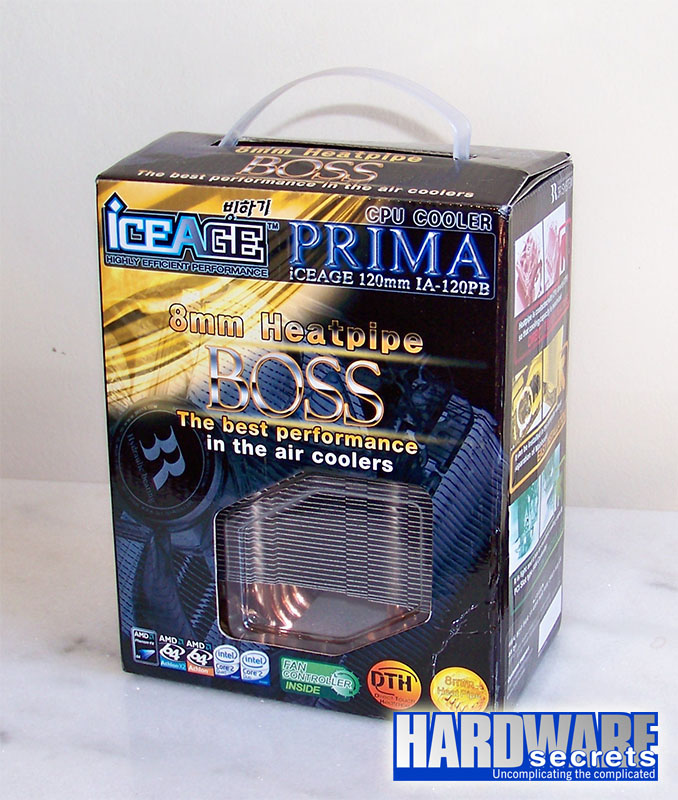 Figure 1: Box.
Figure 1: Box.
Inside the box we fount the heatsink, fan (not installed), user manual, installation hardware and a tube of aluminum-based thermal compound.
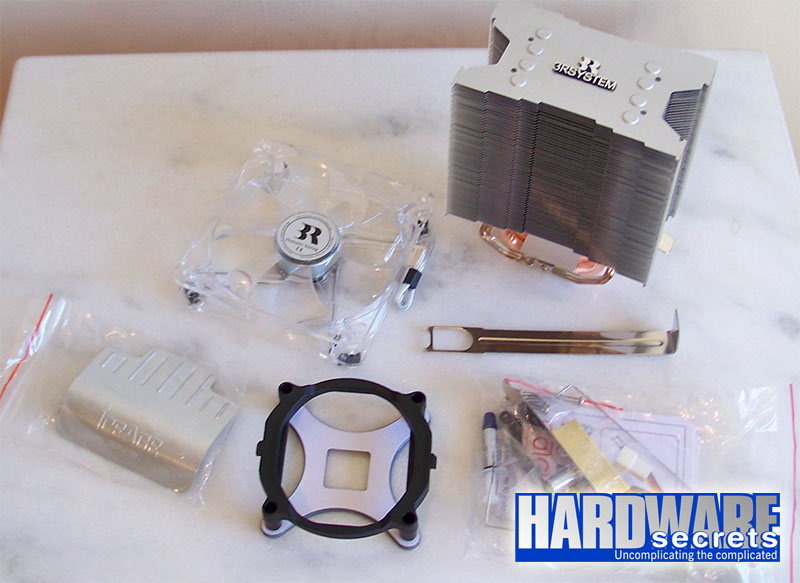 Figure 2: Box contents.
Figure 2: Box contents.
The included fan has no automatic rotation speeds (there is no PWM pin on the connector) but this cooler comes with a fan controller that must be installed in one of the rear slots of the case. You can see this controller in Figure 3.
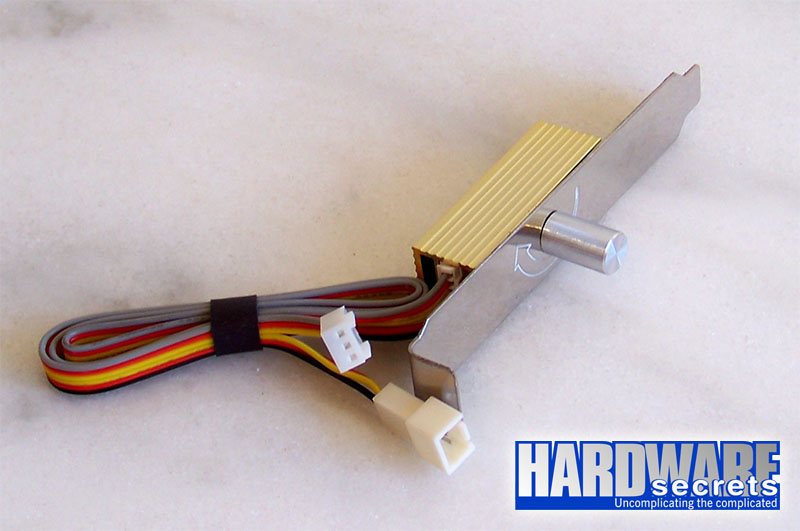 Figure 3: Fan controller.
Figure 3: Fan controller.[nextpage title=”3R System iCEAGE Prima Boss”]
[nextpage title=”3R System iCEAGE Prima Boss (cont’d)”]
The 120 mm fan is made of transparent plastic and has four blue LEDs. There are four small rubber pads between the fan and the heatsink, helping to absorb vibrations.
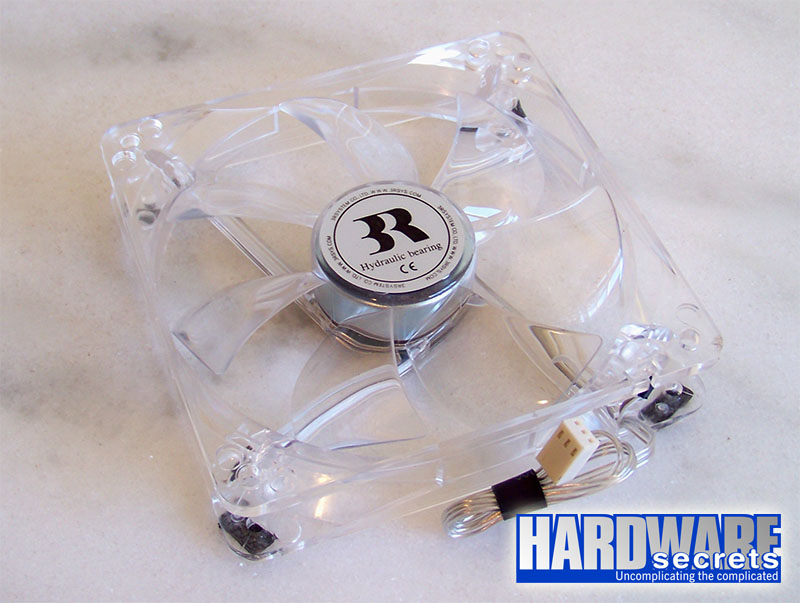 Figure 7: Fan.
Figure 7: Fan.
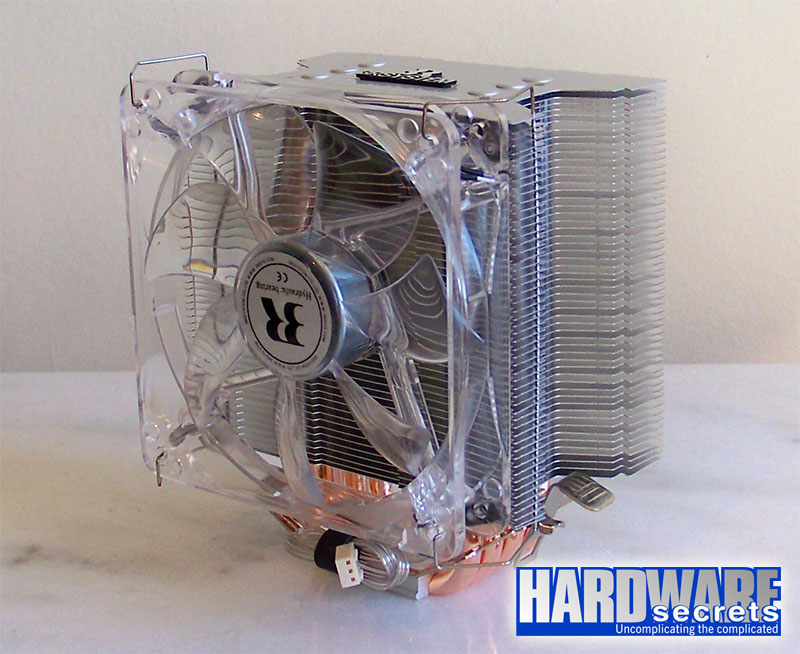 Figure 8: Installed fan.
Figure 8: Installed fan.The base surface of the cooler is formed by the heatpipes themselves, so they keep direct contact with the CPU.
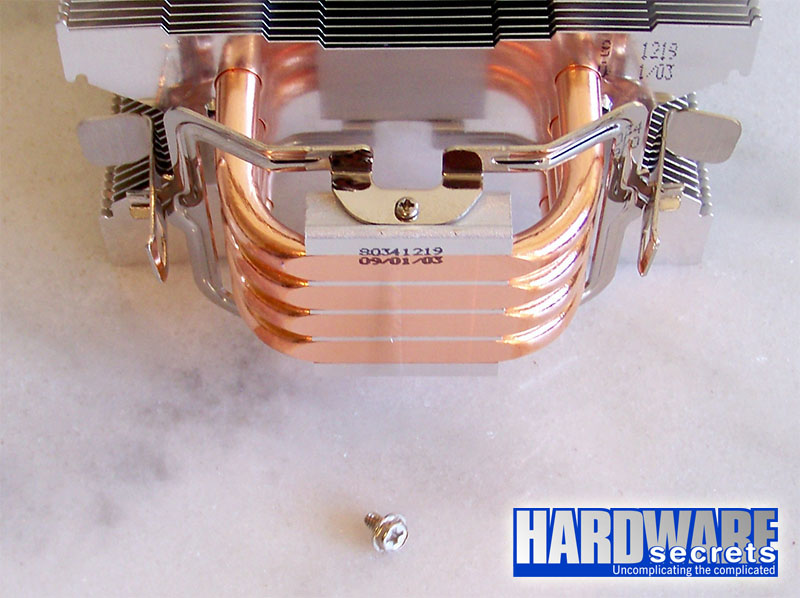 Figure 9: Base.
Figure 9: Base.
There is an aluminum curved plate with the cooler. User manual calls it an airflow deflector but does not show how it must be installed.
 Figure 10: Airflow deflector.
Figure 10: Airflow deflector.
[nextpage title=”Installation”]
To install this cooler on AMD CPUs you just need to fasten the preinstalled clips in the existing motherboard frame. You can see this clips in Figure 11.
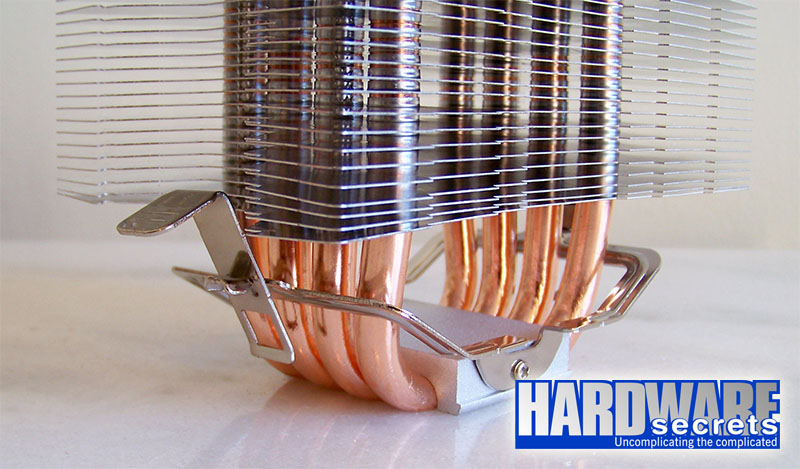 Figure 11: AMD CPUs clips.
Figure 11: AMD CPUs clips.
But to install it on Intel socket LGA775 CPUs you must first install a frame on the motheboard. It uses a backplate on the solder side of the motherboard. In Figure 12 we can see the parts, as well as a long tool to help install and remove the cooler.
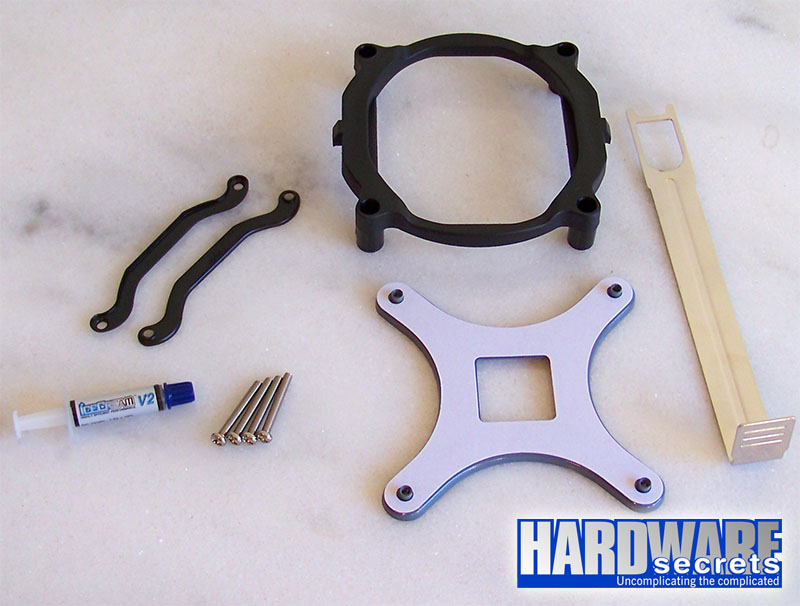 Figure 12: Socket LGA775 hardware.
Figure 12: Socket LGA775 hardware.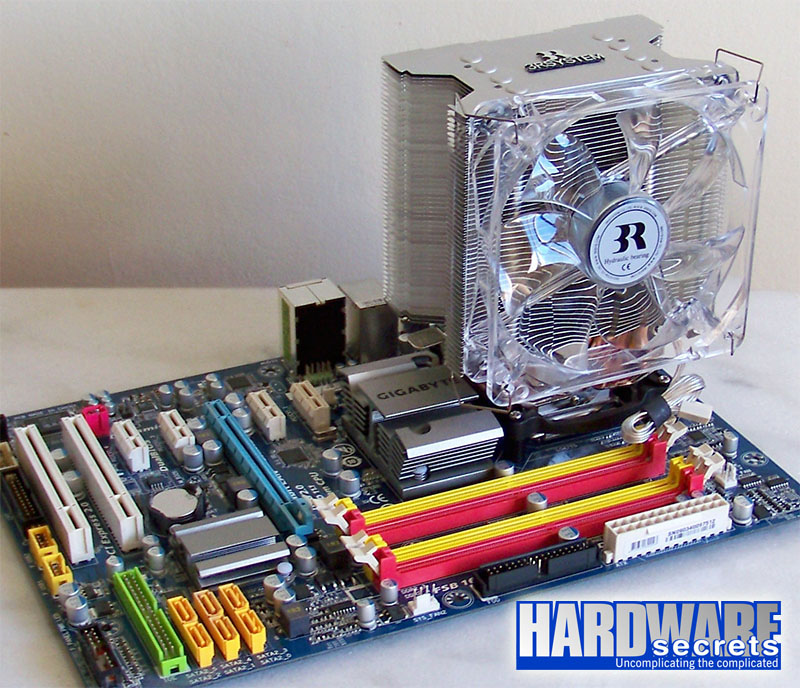 Figure 13: Installed on motherboard.
Figure 13: Installed on motherboard.As every tower cooler with 120 mm fan, it will not fit slim (nor SFF) cases.
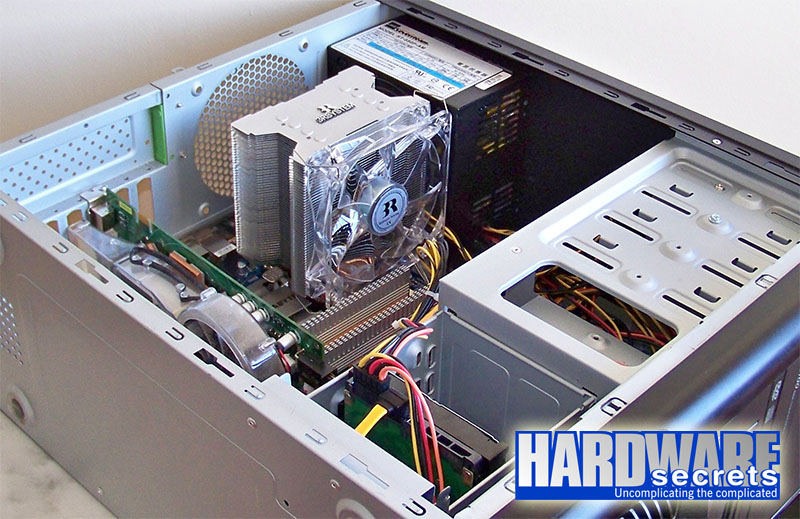 Figure 14: Installed into the case.
Figure 14: Installed into the case.
In Figure 15, you can see the beautiful glow of the fan.
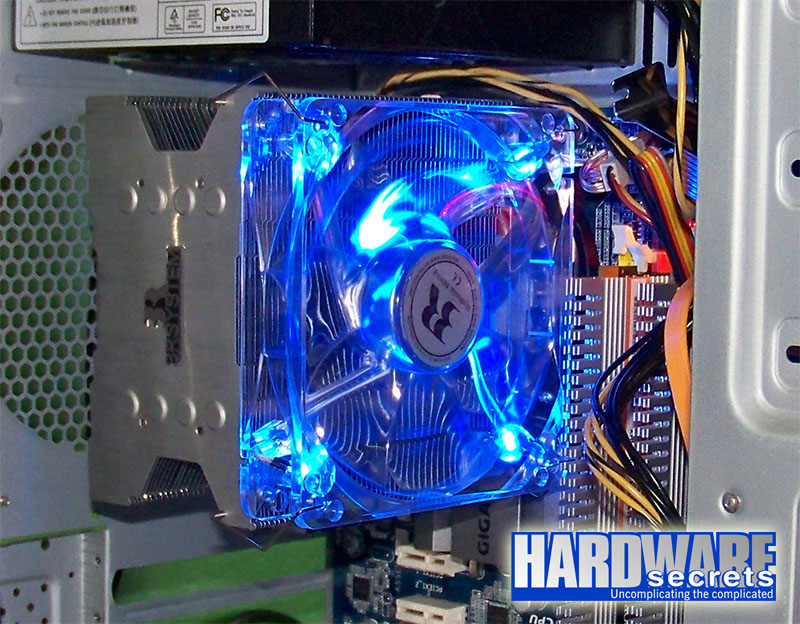 Figure 15: Fan glow.
Figure 15: Fan glow.
[nextpage title=”How We Tested”]
We are adopting the following metodology on our CPU cooler reviews.
First, we chose the CPU with the highest TDP (Thermal Design Power) we had available, a Core 2 Extreme QX6850, which has a 130 W TDP. The choice for a CPU with a high TDP is obvious. To measure the efficiency of the tested cooler, we need a processor that gets very ho
t. This CPU works by default at 3.0 GHz, but we overclocked it to 3.33 GHz, in order to heat it as much as possible.
We took noise and temperature measurements with the CPU idle and under full load. In order to achieve 100% CPU load on the four processing cores we ran Prime95 with the “In-place Large FFTs” option, and three instances of the StressCPU program, all at the same time.
We also compared the reviewed cooler to the Intel stock cooler (with copper base), which comes with the processor we used, and also with some other coolers we have tested using the same methodology.
Temperature measurements were taken with a digital thermometer, with the sensor touching the base of the cooler, and also with the core temperature reading (given by the CPU thermal sensor) from the from the SpeedFan program, using an arithmetic average of the four core temperature readings.
The sound pressure level (SPL) was measured with a digital noise meter, with its sensor placed 4″ (10 cm) from the fan. We turned off the video board cooler so it wouldn’t interfere with the results, but this measurement is only for comparative purposes, because a precise SPL measurement needs to be made inside an acoustically insulated room with no other noise sources, which is not the case here.
Hardware Configuration
- Processor: Core 2 Extreme QX6850
- Motherboard: Gigabyte EP45-UD3L
- Memory: 2 GB Corsair XMS2 DHX TWIN2X2048-6400C4DHX G (DDR2-800/PC2-6400 with timings 4-4-4-12), running at 800 MHz
- Hard drive: 500 GB Seagate Barracuda 7200.11 (ST3500320AS, SATA-300, 7200 rpm, 32 MB buffer)
- Video card: PNY Verto Geforce 9600 GT
- Video resolution: 1680×1050
- Video monitor: Samsung Syncmaster 2232BW Plus
- Power supply required: Seventeam ST-550P-AM
- Case: 3RSystem K100
Software Configuration
- Windows XP Professional installed on FAT32 partition
- Service Pack 3
- Intel Inf driver version: 8.3.1.1009
- NVIDIA video driver version: 182.08
Software Used
Error Margin
We adopted a 2 °C error margin, i.e., temperature differences below 2 °C are considered irrelevant.
[nextpage title=”Our Tests”]
On the tables below you can see our results. We ran the same tests with the Intel stock cooler, Thermaltake BigTyp 14Pro, Akasa Nero, Cooler Master V10, Thermaltake TMG IA1, Zalman CNPS10X Extreme, Thermaltake ISGC-100, Noctua NH-U12P, Noctua NH-C12P, Thermaltake ISGC-200, Scythe Kabuto, Arctic Cooling Alpine 11 Pro, Thermaltake ISGC-300, SilverStone NT06-E, Zalman CNPS9700 NT, Scythe Mugen-2, Thermaltake ISGC-400, Cooler Master Vortex 752 and 3R System iCEAGE Prima Boss. Each test ran with the CPU idle and the with the CPU fully loaded. On BigTyp 14Pro, TMG IA1, NH-U12P and ISGC-300 the tests were done with the fan at full speed and at minimum speed. The other coolers were connected directly to the motherboard and it controls the fan speed based on CPU load level and temperature on PWM models. ISGC-400 and iCEAGE Prima Boss were tested at minimum speed on idle test and at maximum speed on full load test.
|
CPU Idle |
|||||
| Cooler | Room Temp. | Noise | Fan Speed | Base Temp. | Core Temp. |
| Intel stock | 14 °C | 44 dBA | 1000 rpm | 31 °C | 42 °C |
| BigTyp 14Pro (min) | 17 °C | 47 dBA | 880 rpm | 29 °C | 36 °C |
| BigTyp 14Pro (max) | 17 °C | 59 dBA | 1500 rpm | 26 °C | 34 °C |
| Akasa Nero | 18 °C | 41 dBA | 500 rpm | 26 °C | 35 ° |
| Cooler Master V10 | 14 °C | 44 dBA | 1200 rpm | 21 °C | 26 °C |
| TMG IA1 (max) | 16 °C | 47 dBA | 1500 rpm | 22 °C | 30 °C |
| TMG IA1 (min) | 16 °C | 57 dBA | 2250 rpm | 21 °C | 30 °C |
| Zalman CNPS10X Extreme | 16 °C | 44 dBA | 1200 rpm | 21 °C | 29 °C |
| Thermaltake ISGC-100 | 18 °C | 44 dBA | 1450 rpm | 35 °C | 49 °C |
| Noctua NH-U12P (low) | 15 °C | 42 dBA | 1000 rpm | 20 °C | 30 °C |
| Noctua NH-U12P | 15 °C | 46 dBA | 1400 rpm | 20 °C | 28 °C |
| Noctua NH-C12P | 17 °C | 46 dBA | 1400 rpm | 23 °C | 28 °C |
| Thermaltake ISGC-200 | 21 °C | 43 dBA | 1100 rpm | 31 °C | 35 °C |
| Schythe Kabuto | 22 °C | 42 dBA | 800 rpm | 29 °C | 34 °C |
| Arctic Cooling Alpine 11 Pro | 20 °C | 43 dBA | 1500 rpm | 32 °C | 39 °C |
| ISGC-300 (min) | 18 °C | 42 dBA | 800 rpm | 26 °C | 30 °C |
| ISGC-300 (max) | 18 °C | 46 dBA | 1400 rpm | 24 °C | 26 °C |
| SilverStone NT06-E | 21 °C | 66 dBA | 2600 rpm | 30 °C | 41 °C |
| Zalman CNPS9700 NT | 22 °C | 48 dBA | 1700 rpm | 28 °C | 35 °C |
| Scythe Mugen-2 | 17 °C | 41 dBA | 700 rpm | 25 °C | 30 °C |
| ISGC-400 (min) | 17 °C | 44 dBA | 850 rpm | 24 °C | 30 °C |
| Cooler Master Vortex 752 | 20 °C | 48 dBA | 1700 rpm | 32 °C | 44 °C |
| iCEAGE Prima Boss (min) | 22 °C | 42 dBA | 1000 rpm | 29 °C | 36 °C |
|
CPU Fully Loaded |
|||||
| Cooler | Room Temp. | Noise | Fan Speed | Base Temp. | Core Temp. |
| Intel stock | 14 °C | 48 dBA | 1740 rpm | 42 °C | 100 °C |
| BigTyp 14Pro (min) | 17 °C | 47 dBA | 880 rpm | 43 °C | 77 °C |
| BigTyp 14Pro (max) | 17 °C | 59 dBA | 1500 rpm | 35 °C | 70 °C |
| Akasa Nero | 18 °C | 48 dBA | 1500 rpm | 34 °C | 68 °C |
| Cooler Master V10 | 14 °C | 54 dBA | 1900 rpm | 24 °C | 52 °C |
| TMG IA1 (max) | 16 °C | 47 dBA | 1500 rpm | 27 °C | 63 °C |
| TMG IA1 (min) | 16 °C | 57 dBA | 2250 rpm | 25 °C | 60 °C |
| Zalman CNPS10X Extreme | 16 °C | 51 dBA | 1900 rpm | 24 °C | 50 °C |
| Thermaltake ISG-100 | 18 °C | 50 dBA | 1800 rpm | 58 °C | 93 °C |
| Noctua NH-U12P (low) | 15 °C | 42 dBA | 1000 rpm | 28 °C | 59 °C |
| Noctua NH-U12P | 15 °C | 46 dBA | 1400 rpm | 25 °C | 54 °C |
| Noctua NH-C12P | 17 °C | 46 dBA | 1400 rpm | 37 °C | 76 °C |
| Thermaltake ISGC-200 | 21 °C | 48 dBA | 1900 rpm | 42 °C | 68 °C |
| Scythe Kabuto | 22 °C | 47 dBA | 1200 rpm | 38 °C | 63 °C |
| Arctic Cooling Alpine 11 Pro | 20 °C | 51 dBA | 2300 rpm | 49 °C | 85 °C |
| ISGC-300 (min) | 18 °C | 42 dBA | 800 rpm | 36 °C | 64 °C |
| ISGC-300 (max) | 18 °C | 46 dBA | 1400 rpm | 31 °C | 56 °C |
| SilverStone NT06-E | 21 °C | 66 dBA | 2600 rpm | 39 °C | 96 °C |
| Zalman CNPS9700 NT | 22 °C | 56 dBA | 2600 rpm | 34 °C | 63 °C |
| Scythe Mugen-2 | 17 °C | 46 dBA | 1300 rpm | 28 °C | 54 °C |
| ISGC-400 (max) | 17 °C | 47 dBA | 1400 rpm | 36 °C | 69 °C |
| Cooler Master Vortex 752 | 20 °C | 55 dBA | 2300 rpm | 48 °C | 92 °C |
| iCEAGE Prima Boss (max) | 22 °C | 53 dBA | 2000 rpm | 35 °C | 59 °C |
On the graph below you can see the temperature difference between the cooler base and the room temperature with the CPU idle and fully loaded. The values shown are in degrees Celsius. Remember that the lower the number the better the cooling performance.
The next graph will give you an idea on how many degrees Celsius the CPU core was hotter than room temperature during the tests.
[nextpage title=”Main Specifications”]
3R System iCEAGE Prima Boss main features are:
- Application: Socket LGA775, AM3, AM2+, AM2, 939 and 754 processors.
- Fins: Aluminum.
- Base: Aluminum, with copper heatpipes in direct contact to the CPU.
- Heat-pipes: Four 8 mm U-shaped copper heat-pipes.
- Fan: 120 mm.
- Nominal fan speed: 1,000 to 2,200 rpm.
- Fan air flow: 53.3 cfm to 78.5 cfm.
- Maximum power consumption: 4.56 W.
- Nominal noise level: 32 dBA.
- Weight: 1,6 lbs (730 g).
- More information: https://www.3rsys.com
- Average price in the US: We couldn’t find this product being sold in the US market on the day we published this review.
[nextpage title=”Conclusions”]
The 3R System iCEAGE Prima Boss seemed to be a good cooler at first look, but it proved to be an excellent one.
Its performance was on the same level of the best coolers we have tested under this methodology, even with a lower price than most of them. Its noise level is excellent at low speeds and acceptable at maximum settings. We really like the practicality of automatic speed control fans, but the fact this one comes with a manual fan controller that allows you to adjust speed without opening your case is really nice, allowing you to choose if you want maximum performance when noise level does not matter or sacrify a little performance whem silence is desirable or necessary
Finally, the transparent four blue LEDs fan gives an “icy” look to your computer (obviously, if you have a side window on your case).
For all this, the 3R System iCEAGE Prima Boss deserves the Hardware Secrets Golden Award seal.






Leave a Reply